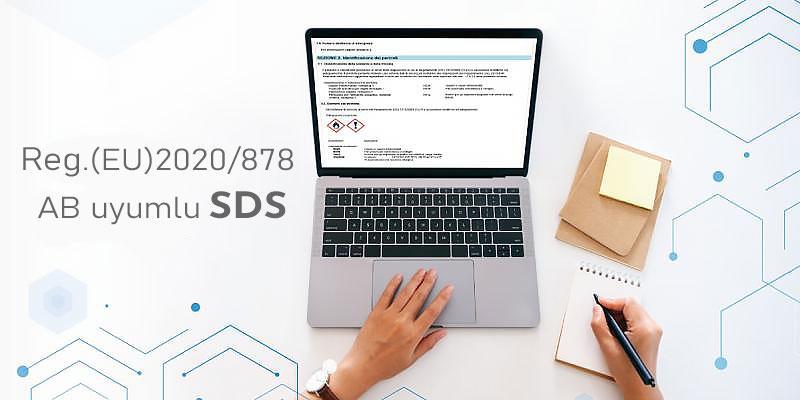
About the Content of EU-Compliant SDSs That Become Mandatory in 2023
What are the innovations brought by Reg. (EU) 2020/878?
Regulation No. (EU) 2020/878; has significantly amended REACH Annex 2 and accordingly the content of Safety Data Sheeets (SDSs) used to provide hazard communication of substances and mixtures. As of 2023, SDSs containing these requirements have become mandatory.
We can list the most important requirements with the amendments as follows:
- Information requirements specific to nanoforms
Reg. (EU) 2018/1881 introduced specific requirements regarding the risk management of nanoforms. In line with these information requirements included in the SDSs, REACH Annex 2 (EC) has been amended.
In each relevant section of the SDS, which nanoforms it covers and safety information about these nanoforms must be specified.
For example; If SDS refers to one or more nanoforms or substances containing nanoforms, this should be indicated in Section 1.1 using the term “nanoform”.
If the substance is registered and includes a nanoform, the particle characteristics that determine the nanoform should be stated in Section 3.1. However, if it’s not registered but includes SDS-nanoforms, the particle characteristics affecting substance safety are specified.
If a substance used in the mixture is in nanoform and is registered as such or addressed in the chemical safety report by the downstream user, the particle characteristics that determine the nanoform must be provided in Section 3.2.
If the substance used in the mixture is in nanoform but is not registered or not covered in the downstream user’s chemical safety report, particle characteristics that affect the mixture safety must be provided.
In another relevant section of the SDS, Chapter 9, regarding nanoforms, the dissolution rate in water or in other relevant biological or environmental media must be specified in addition to the water solubility. Additionally, regarding nanoforms of a substance for which the n-octanol/water partition coefficient is not valid, dispersion stability in different environments should be specified.
The subheading “Particle characteristics”, which is relevant only for solids, has been added to Chapter 9. In this subheading, the particle size (median equivalent diameter, method of calculating the diameter (number, surface, or volume-based), and the range over which this median value varies) are specified. Additionally, other properties such as size distribution (e.g., as a range), shape and aspect ratio, agglomeration and aggregation, specific surface area, and dustiness may be specified. If the substance is in nanoform or the given mixture contains a nanoform, these properties should be stated in the “Particle characteristics” subsection or referenced if stated in a different section of the SDS.
- Information requirements regarding Endocrine Disruptors
In case the substance is included in the list established by the authority because it has endocrine disrupting properties or has endocrine disrupting properties according to the relevant criteria, this information must be provided under the heading of Chapter 2.3 “Other hazards”. For mixtures, information must be provided for each endocrine-disrupting substance present at a concentration greater than or equal to 0.1% by weight.
Substances determined to have endocrine-disrupting characteristics according to the relevant criteria, if present at a concentration equal to or higher than 0.1% by weight, must also be listed under the subheading “Mixture” in Section 3.2.
For substances determined to have endocrine disrupting properties in subsection 2.3, whenever possible; Section 11.2.1 provides information on adverse health effects caused by endocrine disrupting properties under the subheading “Endocrine disrupting properties”.
For substances determined to have endocrine disrupting properties in subsection 2.3, information on the adverse effects caused by endocrine disrupting properties on the environment, where available; It is provided under the subheading “Endocrine disrupting properties” in Section 12.6.
- Including the UFI (Unique Formula Identifier) Code
If UFI is defined for the mixture and the UFI code is specified in any section of the SDS, this code should be stated separately under the subheading "Other identification information" in Section 1.1.
- Additional information requirements regarding substances
For substances reported in Subsection 3.2 of the SDS, the Specific Concentration Limit (SCL), M-coefficient and acute toxicity estimate, if available, should be stated.
With Reg. 2020/878 (July 18, 2020), REACH Annex 2 which describes the requirements for the preparation of SDSs has been amended.
The regulation, which entered into force on the twentieth day following its publication in the Official Journal of the European Union, has been implemented as of January 1, 2021.
SDSs that do not comply with the annex of this regulation (Reg. (EU) 2015/830) continued to be provided until December 31, 2022.
As of 2023, Reg. (EU) 2020/878 compliant SDSs have become a legal obligation in the EU market.
With SDS Authoring Software and chemical management system Epy Plus you don't need to manually track the regulations!
Contact us to get a quote.
